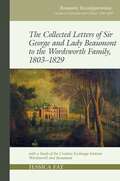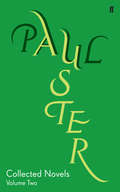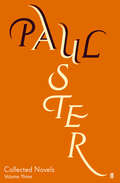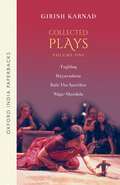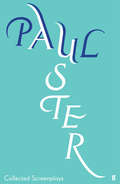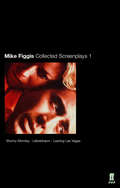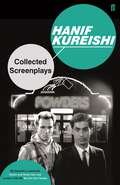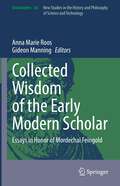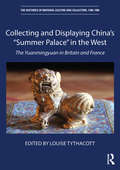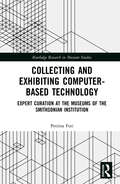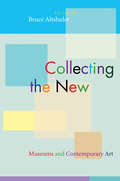- Table View
- List View
The Collected Letters of Sir George and Lady Beaumont to the Wordsworth Family, 1803–1829: with a Study of the Creative Exchange between Wordsworth and Beaumont (Romantic Reconfigurations: Studies in Literature and Culture 1780-1850 #14)
Sir George Beaumont is a key figure in the history of British art. As well as being a respected amateur landscape painter, he was a prominent patron, a collector, and co-founder of the National Gallery. William Wordsworth described Beaumont’s friendship as one of the chief blessings of his life, and this edition reveals that the two men became collaborators as well as companions. In addition to documenting unique perspectives on social, political, and cultural events of the early nineteenth century (providing new contexts for reading Wordsworth’s mature poetry), the letters collected here chart the progress of an increasingly intimate inter-familial relationship. The picture that emerges is of a coterie that – in influence, creativity, and affection – rivals Wordsworth’s more famous exchange with Coleridge at Nether Stowey in the 1790s. The edition includes an extended study of how Wordsworth and Beaumont helped shape one another’s work, tracing processes of mutual artistic development that involved not only a meeting of aristocratic refinement and rural simplicity, of a socialite and a lover of retirement, of a painter and a poet, but also an aesthetic rapprochement between neoclassical and romantic values, between the impulse to idealize and the desire to particularize.
The Collected Letters of William Morris, Volume II, Part A: 1881-1884
by William Morris Norman KelvinThese volumes continue the only complete edition of the surviving correspondence of William Morris (1834- 1896), a protean figure who exerted a major influence as poet, craftsman, master printer, and designer. Covering the years 1881 through 1888, they treat the most dramatic period in another facet of Morris's career: his work as a political activist.Originally published in 1988.The Princeton Legacy Library uses the latest print-on-demand technology to again make available previously out-of-print books from the distinguished backlist of Princeton University Press. These editions preserve the original texts of these important books while presenting them in durable paperback and hardcover editions. The goal of the Princeton Legacy Library is to vastly increase access to the rich scholarly heritage found in the thousands of books published by Princeton University Press since its founding in 1905.
The Collected Letters of William Morris, Volume II, Part B: 1885-1888
by William Morris Norman KelvinThese volumes continue the only complete edition of the surviving correspondence of William Morris (1834- 1896), a protean figure who exerted a major influence as poet, craftsman, master printer, and designer. Covering the years 1881 through 1888, they treat the most dramatic period in another facet of Morris's career: his work as a political activist.Originally published in 1988.The Princeton Legacy Library uses the latest print-on-demand technology to again make available previously out-of-print books from the distinguished backlist of Princeton University Press. These editions preserve the original texts of these important books while presenting them in durable paperback and hardcover editions. The goal of the Princeton Legacy Library is to vastly increase access to the rich scholarly heritage found in the thousands of books published by Princeton University Press since its founding in 1905.
Collected Novels Volume 2
by Paul AusterIn The Music of Chance, the story of Jim Nashe and Jack Pozzi, Auster evokes the strong European influences of Samuel Beckett and Franz Kafka in a brilliant and unsettling parable of loss and gambling. In Leviathan, he makes perhaps his most direct attempt at exploring the political reality of contemporary American life, through the figure of Peter Aaron and his challenge to the complacency of modern life. Finally, in Mr Vertigo Auster crafts a cautionary tale of greed and exploitation in the story of Walt, the irrepressible orphan from the Mid-West, who learns the art of levitation under the tutelage of Master Yehudi. Highly varied, yet instantly recognisable as the work of the same storyteller, these three novels form the next chapter in the ongoing career of one of America's most enduring and fascinating writers. 'Paul Auster is one of those sages with confounding talent - confounding for one because he's simply that good . . . He belongs among Vonnegut, Roth, and DeLillo . . .' Claire Howorth 'Auster truly is a master of his art.' Harper's Bazaar
Collected Novels Volume 3
by Paul AusterIn Timbuktu, troubled Brooklyn poet-saint Willy G. Christmas embarks on one last great adventure in the company of his canine sidekick Mr Bones. In The Book of Illusions a grieving professor finds his obsession with the true-life story of a great silent comedian leading him into a mysterious shadow-world. In Oracle Night a novelist lately recovered from near-fatal illness falls under the spell of a blank notebook that is seemingly the source of eeire premonitions and bewildering events. And in The Brooklyn Follies an uncle and his nephew, both wounded by past misfortunes, wind up in the same Brooklyn neighbourhood and find their lives profoundly affected by a little girl who refuses to speak. Highly varied yet instantly recognisable, these four novels comprise the most recent chapter in the ongoing career of an author now responsible for ten great American novels. 'Auster has an enormous talent for creating worlds that are both fantastic and believable . . . His novels are uniformly difficult to put down, a testament to his storytelling gifts.' San Francisco Chronicle
Collected Plays (OIP): Volume 1
by Girish KarnadThe troubled reign of a fourteenth-century sultan of Delhi helps dramatize the crisis of secular nationhood in post-Independence India. A twelfth century folktale about ‘transposed heads’ offers a path-breaking model for a quintessentially ‘Indian’ theatre in postcolonial times. The folktale about a woman with a snake lover explores gender relations within marriage. Individual human sexuality meets the historical debate on violence in Indian culture. The plays in this volume span roughly the first half of the career of Girish Karnad, one of India’s pre-eminent playwrights. The three-volume set of Karnad’s Collected Plays brings together English versions of his important works. Each volume contains an extensive introduction by theatre scholar Aparna Bhargava Dharwadker, Professor of English and Interdisciplinary Theatre Studies, University of Wisconsin–Madison. The introductions trace the literary and theatrical evolution of Karnad’s work over six decades and position it in the larger context of modern Indian drama. In addition, they comment on Karnad’s place as author and translator in a multilingual performance culture and the relation of his playwriting to his work in the popular media. Each of these volumes serves as a collector’s item, making Karnad’s works accessible to theatre lovers worldwide.
Collected Screenplays
by Paul AusterThis collection of Paul Auster screenplays brings together the film work of a writer whose novels have earned him the reputation as 'one of America's most spectacularly inventive writers.' (Times Literary Supplement) Auster has also brought this sense of restless invention to the art of screenwriting, producing Smoke, Blue in the Face, Lulu on the Bridge and The Inner Life of Martin Frost.The prize-winning Smoke tells the story of a novelist, a cigar store manager, and a black teenager who unexpectedly cross paths and end up changing each other's lives in indelible ways. Set in contemporary Brooklyn, Smoke directly inspired Blue in the Face, a largely improvised comedy shot in a total of six days.Lulu on the Bridge is both a thriller and a fairy tale: when jazz musician Izzy Maurer is accidentally hit by a bullet during a performance in a New York club, he is led on a journey into the strange and sometimes frightening labyrinth of his soul. The Inner Life of Martin Frost follows the mysterious and unsettling experiences that befall writer Martin Frost when he borrows a friend's country house and sets out to write a story about elusive and impossible love.The volume also contains production notes, as well as interviews with Paul Auster about his work in film.
Collected Screenplays: Stormy Monday, Liebestraum, Leaving Las Vegas (Collected Screenplays Ser.)
by Mike FiggisWhether working in England or America, Mike Figgis is one of the most innovative and iconoclastic writer-directors in cinema today, and this collection of screenplays displays the rich diversity of his tastes in style and subject matter.Stormy Monday (1988)In the era of Reagan and Thatcher's 'special relationship', Newcastle hosts a special 'America Week', and US businessman-gangster Frank Cosmo seeks to capitalise by pressurising jazz club owner Finney to sell his premises. Finney receives unexpected assistance from Brendan, his newly-hired young janitor, who is also romancing Kate, an escort girl who works part-time for Cosmo.Liebestraum (1991)Architecture professor Nick Kaminsky travels to Elderstown, Illinois, to be by the bedside of his dying mother. He runs into Paul, an old college friend, whose construction company is demolishing a beautiful old cast-iron department store, scene of a notorious murder / suicide 30 years ago. Nick becomes steadily more fascinated, by the building and its history, and by Paul's beautiful wife, Jane.Leaving Las Vegas (1995)Alcoholic Ben Sanderson loses his Hollywood job, takes his severance pay, and drives to Vegas with the mission of drinking himself to death. On the Strip he encounters working girl Sera: she falls for him, and he moves in with her, at the same time extracting a solemn promise that she will not try to divert him from his chosen path of self-annihilation.
Collected Screenplays
by Hanif KureishiHanif Kureishi's cinematic storytelling embraces a wide spectrum of characters from all classes and nationalities, depicting them with compassion, humour and relish, though never fighting shy of controversy. This volume comprises four of Kureishi's screenplays.My Beautiful Laundrette (1985)Omar is a restless young Asian man, caring for his alcoholic father in the hustling London of the mid-1980s. His uncle, a keen Thatcherite, offers Omar an entrepreneurial opportunity to revamp a dingy laundrette, and ambitious Omar rolls up his sleeves, enlisting the assistance of his old school-friend Johnny, who has since fallen in with a gang of neo-fascists. Omar and Johnny soon form an unlikely alliance that leads to business success, as well as other, more intimate surprises.Sammy and Rosie Get Laid (1987)1980s London, and Sammy and Rosie share an 'open' marriage, strings of lovers, and a bohemian existence amidst inner-city turmoil. Sammy's father, Rafi, formerly a government minister in India, visits London as racial tensions rise with the death of a woman in a police raid. Rafi offers Sammy financial assistance if the couple will leave their 'war zone' behind them and produce grandchildren. But Rafi's own shady past threatens to haunt him.London Kills Me (1991)A weekend in the lives of homeless Clint and his pal Muffdiver, youthful veterans of the streets of London, whose chief source of income derives from selling drugs to the wealthier denizens of Notting Hill. But what Clint wants more than anything else is a proper job, and he's been promised a position as a waiter in a restaurant - on the condition that he can come up with a pair of 'sensible' shoes.My Son the Fanatic (1997)Parvez is a Pakistani cab driver in a northern industrial town who chauffeurs young prostitute Bettina. Their gentle friendship grows more tender as Parvez's home life starts to crumble, his son Farid embracing a fundamentalist sect of Islam and rejecting his father's values. When Farid then involves himself with a group committed to purging the town of corruption, Parvez is compelled to choose where his loyalties lie.
Collected Wisdom of the Early Modern Scholar: Essays in Honor of Mordechai Feingold (Archimedes #64)
by Anna Marie Roos Gideon ManningThis book brings together leading scholars in the history of science, history of universities, intellectual history, and the history of the Royal Society, to honor Professor Mordechai Feingold. The essays collected here reflect the impact Feingold's scholarship has had on a range of fields and address several topics, including: the dynamic pedagogical techniques employed in early modern universities, networks of communication through which scientific knowledge was shared, experimental techniques and knowledge production, the life and times of Isaac Newton, Newton's reception, and the scientific culture of the Royal Society. Modeling the interdisciplinary approaches championed by Feingold as well as the essential role of archival studies, the volume attests to the enduring value of his scholarship and sets a benchmark for future work in the history of science and its allied fields.
Collecting: Psychological Perspectives (PDF)
by Werner MuensterbergerFrom rare books, valuable sculpture and paintings, the relics of saints, and porcelain and other precious items, through stamps, textiles, military ribbons, and shells, to baseball cards, teddy bears, and mugs, an amazing variety of objects have engaged and even obsessed collectors through the ages. With this captivating book the psychoanalyst Werner Muensterberger provides the first extensive psychological examination of the emotional sources of the never-ending longing for yet another collectible. Muensterberger's roster of driven acquisition-hunters includes the dedicated, the serious, and the infatuated, whose chronic restlessness can be curbed--and then merely temporarily--only by purchasing, discovering, receiving, or even stealing a new "find." In an easy, conversational style, the author discusses the eccentricities of heads of state, literary figures, artists, and psychoanalytic patients, all possessed by a need for magic relief from despair and helplessness--and for the self-healing implied in the phrase "I can't live without it!" The sketches here are diverse indeed: Walter Benjamin, Mario Praz, Catherine the Great, Poggio Bracciolini, Brunelleschi, and Jean de Berry, among others.The central part of the work explores in detail the personal circumstances and life history of three individuals: a contemporary collector, Martin G; the celebrated British book and manuscript collector Sir Thomas Phillipps, who wanted one copy of every book in the world; and the great French novelist Honoré de Balzac, a compulsive collector of bric-a-brac who expressed his empathy for the acquisitive passions of his collector protagonist in Cousin Pons. In addition, Muensterberger takes the reader on a charming tour of collecting in the Renaissance and looks at collecting during the Golden Age of Holland, in the seventeenth century. Throughout, we enjoy the author's elegant variations on a complicated theme, stated, much too simply, by John Steinbeck: "I guess the truth is that I simply like junk."Originally published in 1993.The Princeton Legacy Library uses the latest print-on-demand technology to again make available previously out-of-print books from the distinguished backlist of Princeton University Press. These editions preserve the original texts of these important books while presenting them in durable paperback and hardcover editions. The goal of the Princeton Legacy Library is to vastly increase access to the rich scholarly heritage found in the thousands of books published by Princeton University Press since its founding in 1905.
Collecting and Conserving Net Art: Moving beyond Conventional Methods
by Annet DekkerCollecting and Conserving Net Art explores the qualities and characteristics of net art and its influence on conservation practices. By addressing and answering some of the challenges facing net art and providing an exploration of its intersection with conservation, the book casts a new light on net art, conservation, curating and museum studies. Viewing net art as a process rather than as a fixed object, the book considers how this is influenced by and executed through other systems and users. Arguing that these processes and networks are imbued with ambiguity, the book suggests that this is strategically used to create suspense, obfuscate existing systems and disrupt power structures. The rapid obsolescence of hard and software, the existence of many net artworks within restricted platforms and the fact that artworks often act as assemblages that change or mutate, make net art a challenging case for conservation. Taking the performative and interpretive roles conservators play into account, the book demonstrates how practitioners can make more informed decisions when responding to, critically analysing or working with net art, particularly software-based processes. Collecting and Conserving Net Art is intended for researchers, academics and postgraduate students, especially those engaged in the study of museum studies, conservation and heritage studies, curatorial studies, digital art and art history. The book should also be interesting to professionals who are involved in the conservation and curation of digital arts, performance, media and software.
Collecting and Conserving Net Art: Moving beyond Conventional Methods
by Annet DekkerCollecting and Conserving Net Art explores the qualities and characteristics of net art and its influence on conservation practices. By addressing and answering some of the challenges facing net art and providing an exploration of its intersection with conservation, the book casts a new light on net art, conservation, curating and museum studies. Viewing net art as a process rather than as a fixed object, the book considers how this is influenced by and executed through other systems and users. Arguing that these processes and networks are imbued with ambiguity, the book suggests that this is strategically used to create suspense, obfuscate existing systems and disrupt power structures. The rapid obsolescence of hard and software, the existence of many net artworks within restricted platforms and the fact that artworks often act as assemblages that change or mutate, make net art a challenging case for conservation. Taking the performative and interpretive roles conservators play into account, the book demonstrates how practitioners can make more informed decisions when responding to, critically analysing or working with net art, particularly software-based processes. Collecting and Conserving Net Art is intended for researchers, academics and postgraduate students, especially those engaged in the study of museum studies, conservation and heritage studies, curatorial studies, digital art and art history. The book should also be interesting to professionals who are involved in the conservation and curation of digital arts, performance, media and software.
Collecting and Displaying China's “Summer Palace” in the West: The Yuanmingyuan in Britain and France (The Histories of Material Culture and Collecting, 1700-1950)
by Edited by Louise TythacottIn October 1860, at the culmination of the Second Opium War, British and French troops looted and destroyed one of the most important palace complexes in imperial China—the Yuanmingyuan. Known in the West as the "Summer Palace," this site consisted of thousands of buildings housing a vast art collection. It is estimated that over a million objects may have been taken from the palaces in the Yuanmingyuan—and many of these are now scattered around the world, in private collections and public museums. With contributions from leading specialists, this is the first book to focus on the collecting and display of "Summer Palace" material over the past 150 years in museums in Britain and France. It examines the way museums placed their own cultural, political and aesthetic concerns upon Yuanmingyuan material, and how displays—especially those at the Royal Engineers Museum in Kent, the National Museum of Scotland and the Musée Chinois at the Château of Fontainebleau—tell us more about European representations and images of China, than they do about the Yuanmingyuan itself.
Collecting and Displaying China's “Summer Palace” in the West: The Yuanmingyuan in Britain and France (The Histories of Material Culture and Collecting, 1700-1950)
In October 1860, at the culmination of the Second Opium War, British and French troops looted and destroyed one of the most important palace complexes in imperial China—the Yuanmingyuan. Known in the West as the "Summer Palace," this site consisted of thousands of buildings housing a vast art collection. It is estimated that over a million objects may have been taken from the palaces in the Yuanmingyuan—and many of these are now scattered around the world, in private collections and public museums. With contributions from leading specialists, this is the first book to focus on the collecting and display of "Summer Palace" material over the past 150 years in museums in Britain and France. It examines the way museums placed their own cultural, political and aesthetic concerns upon Yuanmingyuan material, and how displays—especially those at the Royal Engineers Museum in Kent, the National Museum of Scotland and the Musée Chinois at the Château of Fontainebleau—tell us more about European representations and images of China, than they do about the Yuanmingyuan itself.
Collecting and Exhibiting Computer-Based Technology: Expert Curation at the Museums of the Smithsonian Institution (Routledge Research in Museum Studies)
by Petrina FotiComputer technology has transformed modern society, yet curators wishing to reflect those changes face difficult challenges in terms of both collecting and exhibiting. Collecting and Exhibiting Computer-Based Technology examines how curators at the history and technology museums of the Smithsonian Institution have met these challenges. Focusing on the curatorial process, the book explores the ways in which curators at the institution have approached the accession and display of technological artifacts. Such collections often have comparatively few precedents, and can pose unique dilemmas. In analysing the Smithsonian’s approach, Foti takes in diverse collection case studies ranging from DNA analyzers to Herbie Hancock’s music synthesizers, from iPods to born-digital photographs, from the laptop used during the filming of the television program Sex and the City to "Stanley" the self-driving car. Using her proposed model of "expert curation", she synthesizes her findings into a more universal framework for undertanding the curatorial methods associated with computer technology and reflects on what it means to be a curator in a postdigital world. Collecting and Exhibiting Computer-Based Technology offers a detailed analysis of curatorial practice in a relatively new field that is set to grow exponentially. It will be useful reading for curators, scholars, and students alike.
Collecting and Exhibiting Computer-Based Technology: Expert Curation at the Museums of the Smithsonian Institution (Routledge Research in Museum Studies)
by Petrina FotiComputer technology has transformed modern society, yet curators wishing to reflect those changes face difficult challenges in terms of both collecting and exhibiting. Collecting and Exhibiting Computer-Based Technology examines how curators at the history and technology museums of the Smithsonian Institution have met these challenges. Focusing on the curatorial process, the book explores the ways in which curators at the institution have approached the accession and display of technological artifacts. Such collections often have comparatively few precedents, and can pose unique dilemmas. In analysing the Smithsonian’s approach, Foti takes in diverse collection case studies ranging from DNA analyzers to Herbie Hancock’s music synthesizers, from iPods to born-digital photographs, from the laptop used during the filming of the television program Sex and the City to "Stanley" the self-driving car. Using her proposed model of "expert curation", she synthesizes her findings into a more universal framework for undertanding the curatorial methods associated with computer technology and reflects on what it means to be a curator in a postdigital world. Collecting and Exhibiting Computer-Based Technology offers a detailed analysis of curatorial practice in a relatively new field that is set to grow exponentially. It will be useful reading for curators, scholars, and students alike.
Collecting as Modernist Practice (Hopkins Studies in Modernism)
by Jeremy BraddockIn this highly original study, Jeremy Braddock focuses on collective forms of modernist expression—the art collection, the anthology, and the archive—and their importance in the development of institutional and artistic culture in the United States.Using extensive archival research, Braddock's study synthetically examines the overlooked practices of major American art collectors and literary editors: Albert Barnes, Alain Locke, Duncan Phillips, Alfred Kreymborg, Amy Lowell, Ezra Pound, Katherine Dreier, and Carl Van Vechten. He reveals the way collections were devised as both models for modernism's future institutionalization and culturally productive objects and aesthetic forms in themselves. Rather than anchoring his study in the familiar figures of the individual poet, artist, and work, Braddock gives us an entirely new account of how modernism was made, one centered on the figure of the collector and the practice of collecting.Collecting as Modernist Practice demonstrates that modernism's cultural identity was secured not so much through the selection of a canon of significant works as by the development of new practices that shaped the social meaning of art. Braddock has us revisit the contested terrain of modernist culture prior to the dominance of institutions such as the Museum of Modern Art and the university curriculum so that we might consider modernisms that could have been. Offering the most systematic review to date of the Barnes Foundation, an intellectual genealogy and analysis of The New Negro anthology, and studies of a wide range of hitherto ignored anthologies and archives, Braddock convincingly shows how artistic and literary collections helped define the modernist movement in the United States.
Collecting as Modernist Practice (Hopkins Studies in Modernism)
by Jeremy BraddockIn this highly original study, Jeremy Braddock focuses on collective forms of modernist expression—the art collection, the anthology, and the archive—and their importance in the development of institutional and artistic culture in the United States.Using extensive archival research, Braddock's study synthetically examines the overlooked practices of major American art collectors and literary editors: Albert Barnes, Alain Locke, Duncan Phillips, Alfred Kreymborg, Amy Lowell, Ezra Pound, Katherine Dreier, and Carl Van Vechten. He reveals the way collections were devised as both models for modernism's future institutionalization and culturally productive objects and aesthetic forms in themselves. Rather than anchoring his study in the familiar figures of the individual poet, artist, and work, Braddock gives us an entirely new account of how modernism was made, one centered on the figure of the collector and the practice of collecting.Collecting as Modernist Practice demonstrates that modernism's cultural identity was secured not so much through the selection of a canon of significant works as by the development of new practices that shaped the social meaning of art. Braddock has us revisit the contested terrain of modernist culture prior to the dominance of institutions such as the Museum of Modern Art and the university curriculum so that we might consider modernisms that could have been. Offering the most systematic review to date of the Barnes Foundation, an intellectual genealogy and analysis of The New Negro anthology, and studies of a wide range of hitherto ignored anthologies and archives, Braddock convincingly shows how artistic and literary collections helped define the modernist movement in the United States.
Collecting Prints, Posters, and Ephemera: Perspectives in a Global World (Contextualizing Art Markets)
by Ruth E. Iskin Britany SalsburyWhy did collectors seek out posters and collect ephemera during the late-nineteenth and the twentieth centuries? How have such materials been integrated into institutional collections today? What inspired collectors to build significant holdings of works from cultures other than their own? And what are the issues facing curators and collectors of digital ephemera today? These are among the questions tackled in this volume-the first to examine the practices of collecting prints, posters, and ephemera during the modern and contemporary periods. A wide range of case studies feature collections of printed materials from the United States, Latin America, France, Germany, Great Britain, China, Japan, Russia, Iran, and Cuba. Fourteen essays and one roundtable discussion, all specially commissioned from art historians, curators, and collectors for this volume, explore key issues such as the roles of class, politics, and gender, and address historical contexts, social roles, value, and national and transnational aspects of collecting practices. The global scope highlights cross-cultural connections and contributes to a new understanding of the place of prints, posters and ephemera within an increasingly international art world.
Collecting Prints, Posters, and Ephemera: Perspectives in a Global World (Contextualizing Art Markets)
Why did collectors seek out posters and collect ephemera during the late-nineteenth and the twentieth centuries? How have such materials been integrated into institutional collections today? What inspired collectors to build significant holdings of works from cultures other than their own? And what are the issues facing curators and collectors of digital ephemera today? These are among the questions tackled in this volume-the first to examine the practices of collecting prints, posters, and ephemera during the modern and contemporary periods. A wide range of case studies feature collections of printed materials from the United States, Latin America, France, Germany, Great Britain, China, Japan, Russia, Iran, and Cuba. Fourteen essays and one roundtable discussion, all specially commissioned from art historians, curators, and collectors for this volume, explore key issues such as the roles of class, politics, and gender, and address historical contexts, social roles, value, and national and transnational aspects of collecting practices. The global scope highlights cross-cultural connections and contributes to a new understanding of the place of prints, posters and ephemera within an increasingly international art world.
Collecting, Processing and Presenting Geoscientific Information: MATLAB® and Design Recipes for Earth Sciences (Springer Textbooks in Earth Sciences, Geography and Environment)
by Martin H. Trauth Elisabeth SillmannThis second edition is an intensively revised and updated version of the book MATLAB® and Design Recipes for Earth Sciences. It aims to introduce students to the typical course followed by a data analysis project in earth sciences. A project usually involves searching relevant literature, reviewing and ranking published books and journal articles, extracting relevant information from the literature in the form of text, data, or graphs, searching and processing the relevant original data using MATLAB, and compiling and presenting the results as posters, abstracts, and oral presentations using graphics design software. The text of this book includes numerous examples on the use of internet resources, on the visualization of data with MATLAB, and on preparing scientific presentations. As with the book MATLAB Recipes for Earth Sciences–4rd Edition (2015), which demonstrates the use of statistical and numerical methods on earth science data, this book uses state-of-the art software packages, including MATLAB and the Adobe Creative Suite, to process and present geoscientific information collected during the course of an earth science project. The book's supplementary electronic material (available online through the publisher's website) includes color versions of all figures, recipes with all the MATLAB commands featured in the book, the example data, exported MATLAB graphics, and screenshots of the most important steps involved in processing the graphics.
Collecting the New: Museums and Contemporary Art (PDF)
by Bruce AltshulerCollecting the New is the first book on the questions and challenges that museums face in acquiring and preserving contemporary art. Because such art has not yet withstood the test of time, it defies the traditional understanding of the art museum as an institution that collects and displays works of long-established aesthetic and historical value. By acquiring such art, museums gamble on the future. In addition, new technologies and alternative conceptions of the artwork have created special problems of conservation, while social, political, and aesthetic changes have generated new categories of works to be collected. Following Bruce Altshuler's introduction on the European and American history of museum collecting of art by living artists, the book comprises newly commissioned essays by twelve distinguished curators representing a wide range of museums. First considered are general issues including the acquisition process, and collecting by universal survey museums and museums that focus on modern and contemporary art. Following are groups of essays that address collecting in particular media, including prints and drawings, new (digital) media, and film and video; and national- and ethnic-specific collecting (contemporary art from Asia, Africa, and Latin America, and African-American art). The closing essay examines the conservation problems created by contemporary works--for example, what is to be done when deterioration is the artist's intent? The contributors are Christophe Cherix, Vishakha N. Desai, Steve Dietz, Howard N. Fox, Chrissie Iles and Henriette Huldisch, Pamela McClusky, Gabriel Pérez-Barreiro, Lowery Stokes Sims, Robert Storr, Jeffrey Weiss, and Glenn Wharton.
Collecting the Now: On the Financial Side of Postwar Art History
by Michael MaizelsCollecting the Now offers a new, in-depth look at the economic forces and institutional actors that have shaped the outlines of postwar art history, with a particular focus on American art, 1960–1990. Working through four case studies, Michael Maizels illuminates how a set of dealers and patrons conditioned the iconic developments of this period: the profusions of pop art, the quixotic impossibility of land art, the dissemination of new media, and the speculation-fueled neo-expressionist painting of the 1980s. This book addresses a question of pivotal importance to a swath of art history that has already received substantial scholarly investigation. We now have a clear, nuanced understanding of why certain evolutions took place: why pop artists exploded the delimited parameters of aesthetic modernism, why land artists further strove against the object form itself, and why artists returned to (neo-)traditional painting in the 1980s. But remarkably elided by extant scholarship has been the question of how. How did conditions coalesce around pop so that its artists entered into museum collections, and scholarly analyses, at pace unprecedented in the prior history of art? How, when seeking to transcend the delimited gallery object, were land artists able to create monumental (and by extension, monumentally expensive), interventions in the extreme wilds of the Western deserts? And how did the esoteric objects of media art come eventually to scholarly attention in the sustained absence of academic interest or a private market? The answers to these questions lie in an exploration of the financial conditions and funding mechanisms through which these works were created, advertised, distributed, and preserved.
Collecting the Past: British Collectors and their Collections from the 18th to the 20th Centuries (Routledge Research in Museum Studies)
by Toby Burrows Cynthia JohnstonToday’s libraries and museums are heavily indebted to the passions and obsessions of numerous individual collectors who devoted their lives to amassing collections of books, manuscripts, artworks, and other culturally significant objects. Collecting the Past brings together the latest research on a wide range of significant British collectors from the eighteenth to the twentieth centuries, including Hans Sloane, Sarah Sophia Banks, Thomas Phillipps, Sydney Cockerell, J. P. Morgan Jr., Alfred Chester Beatty and R. E. Hart. Contributors to the volume examine the phenomenon of collecting in a variety of settings and across a range of different materials. Considering the aims and motives that led these collectors to assemble such remarkable collections, the book also examines the history of these collections after the collector’s death. Particular attention is given to the often complicated relationship between collectors and the public institutions that subsequently came to house their collections. Situated within the framework of cultural collecting more generally, this book offers an authoritative series of essays on key collectors. Collecting the Past should be most interesting to researchers, academics and postgraduate students engaged in the study of museum studies, book history, manuscript studies, museum history, library history and the history of collecting. Professionals in libraries, museums and galleries will also find the volume of great interest.
